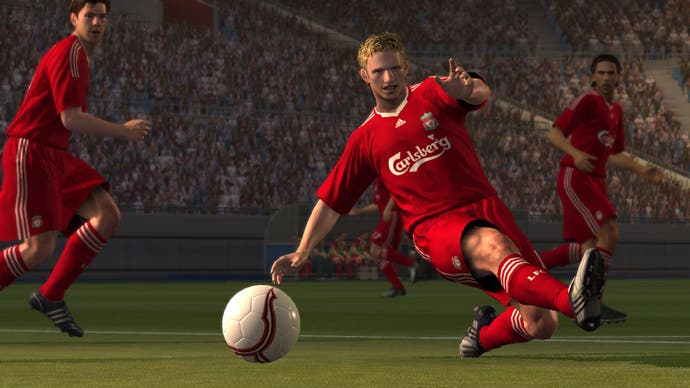Pro Evolution Soccer 2009
Back of the net or back of the queue?
In hindsight, we'd go one further. The myth that EA makes the bimbo football game and Konami makes the cultured one is - to return to the note upon which we began our FIFA 09 review - thoroughly dead. But that doesn't necessarily mean the same is now true in reverse. FIFA 09 may be excellent, and the last few Pro Evolutions have gone backwards, but what of PES 2009?
At its heart, we suspect, lie many of the same lines of code that drove the success of the series on PS2 for so many seasons, because the fundamentals are unchanged: player movement is on eight directions (with in-betweens during sprints), passing is zippy, and ball movement is physically convincing, if a little heavy. The graphics reinforce the impression that PES is reliant on existing content and assets, too, because despite the usual claim that it's "undergone a stunning graphical update", movement animations are wooden and repetitive, and the players look more like they've undergone a stunning facial beating under a railway bridge.
FIFA, by inevitable comparison, is so smoothly plastered with graphical Polyfilla that almost every angle of ball receipt, every tweak of the analogue stick, is covered by an appropriate animation, which frees the players and football to move organically in ways that PES wouldn't countenance. It's not quite that perfect, but the fact is we used to talk about the difference between PES' loose ball and FIFA's gluey boots, and these days it's the difference between PES' grids of movement and FIFA's cloud of possibilities. No wonder Peter Moore's crowing about the review scores.
But while the visual comparison between PES and FIFA is now rather harsh on EA's Japanese adversary, Konami's re-minted PES Production Team in Tokyo is a bit like the James Bond film crews - their grandfathers worked on this stuff, doncha know, and they know a bit about it. So it shouldn't be a surprise to discover that while PES 2009 lacks FIFA 09's fluency - graphically and mechanically - and the EA game's authoritative command of licences, it still plays much better than last year's effort thanks to a few nips and tucks, and gives PES fans who can't break away from its hard-coded diagonals and toxic waste likenesses their best return for a few years.

PES moves at a fair old trot, and while the attacking principles are the same as they are in FIFA - pass the ball, retain possession, go backwards when you can't go forward, drag players out of position to make space, be ruthless when you do - wing play is more effective, with a high frequency of goals from diving or jumping headers, and the trick moves that used to be on the right analogue stick have now migrated to the d-pad or left stick (whichever you use for movement), so they're easy to incorporate into your approach play, rather than an afterthought. Nippy strikers and wingers have less trouble holding onto the ball under duress, too, reaching the byline fairly often in spite of typically adhesive pursuing defenders.
This is because, absent the need to counterbalance FIFA's omnidirectional player brains, PES doesn't have to be so rugged and physical. Defensive pressing is more about pushing wingers inside or driving your opponents down blind alleys. Aggressive pressing with two players - similarly suicidal in both games, since it leaves tons of space for AI or a wily human opponent to exploit - results in a fair few niggly trips, but there's less bullying. If you want the ball, you're going to have to chase it and earn it, which in turn encourages patience in attack. Once you have it, as with FIFA, the basic vocabulary of controls and a sensible approach will bring you results, but there's a huge range of subtleties to master, whether it's different types of pass, cross and shot, flair techniques, off the ball instructions, when it's best to make substitutions, and so on.


